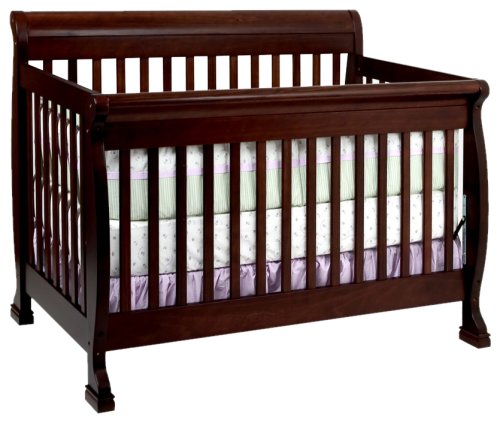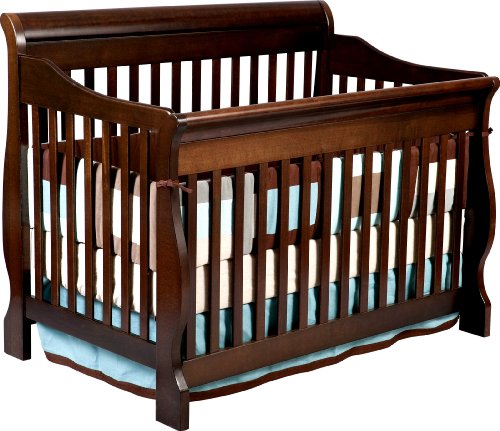An article from CNN "Missing 5-Day-Old Girl Found in Texas" demonstrates the reality of infant abduction. "On June 5, 2006 an ailing 5-day-old girl, snatched from her mother by a woman who had posed as a hospital worker, has been found and is being evaluated at University Medical Center," hospital spokesman Greg Bruce said according to the article.
Convertible Crib Set
The article states, "It appears that she established something of a relationship -- went in the hospital, presented herself as a nurse, checked on the status of the baby and that kind of stuff," said Lt. Roy Basset, a Lubbock Police Department spokesman.
Convertible Crib Set
According to everyone involved in this particular abduction, no one suspected the woman to be a fraud. She even wore scrubs and had a fake ID. Still, it was clear that this incident was something the woman had been planning over a period of several days.
From 1983 to 1998, 177 infants were abducted according to the national Center for Missing and Exploited Children. Of that total, 100 babies were taken from the hospital (57 from the mother's hospital room) and 94 were recovered. According to JCAHO, infant abductions are usually premeditated acts; however, in most cases the particular infant abducted is taken out of impulse or opportunity.
According to Child Find (www.childfind.org) there is a general profile for potential abductors and the infants abducted. These behaviors/characteristics should be known by hospital staff and mothers.
Profile of the Abductor
o Usually female and on average 30-years-old.
o Normally overweight
o Generally no prior criminal record.
o Appearing normal, but emotionally immature or compulsive.
o Has low self-esteem
o Wants to replace a lost infant or one unable to conceive.
o Announces "phantom" pregnancy and prepares for an awaiting birth as an expectant mother would.
o Will make themselves known and become familiar with the hospital personnel and even the infant's parents.
o Usually visits the nursery prior to the abduction asking detailed questions about hospital procedures and unit layout.
o May visit more than one hospital to assess security measures and explore infant populations
o Might not target a particular infant, but take the most available.
o Unlikely to leave the community from which the infant was taken.
Profile of the Infant
o Usually seven days old or younger.
o Perceived by the abductor as their newborn.
o Same race as the abductor or abductor's companion.
Prevention Tips
Safety and security are key areas that should be involved in systems designed to prevent infant abduction. Multiple vendors have products, alarms, and other measures for protection. Hospitals should evaluate the various product options to ensure selections meet their needs.
Additionally, hospitals should establish specific guidelines for staff to follow in the event of an infant abduction. Families should also be instructed concerning abduction prevention.
The following are information and ideas to aid in creating guidelines and precautions for infant abduction prevention.
From ankle bracelets to private entrance codes, hospitals go to great lengths to provide a secure environment for mothers and their newborns.
Safe Environment
The hospital environment should be assessed for potential security measures. Make sure your hospital is equipped with the following:
o Security cameras in strategic locations like the nursery, stairwells, doorways, elevators, and hallways to monitor the incoming and outgoing activity.
o Fire doors equipped with special alarms. Install alarms with time-delay locks on stairwells and exit doors.
o Consider installing an electronic surveillance detection system.
o Use baby identification bands and check the band number with the mother/father/caregiver's number before giving the infant to either parent. Also, staff should know to check the same bands for corresponding numbers before the infant is released from the hospital.
o Electronic key-card system in newborn areas for staff.
o Nurseries and maternity wards are located away from lobbies with street access with doors always locked.
Patient Information
Measures for infant identification include a variety of standard methods plus new devices:
o Foot prints
o Hand/finger prints
o Head shots
o Written description of the infant, medical records, and special identifying marks
o Infant Protection Systems with baby identification bracelets and alarms (www.Accutech-ICS.com). Such systems have special ID devices that will set off alarms if the bracelet is cut or if an infant is taken from the unit/facility without permission.
o Numbered umbilical cord clamps with matching identification wrist bands. These bands should be secured on the infant's ankle and wrist and the matching two should be placed on both the mother and father/caregiver's wrists.
o Mark infant gowns at the neckline with the hospital name and logo so the infant is able to be quickly identified as a patient of the hospital.
o Infant blankets should be marked on all four corners so the infant is readily identified as a patient of the hospital.
Staff Identification
Proper identification of hospital personnel is critical as an abductor may pose as a nurse, doctor, or other staff member.
o All hospital personnel must wear photo identification badges with the hospital logo. Each ID badge must be worn on the outside of their clothing with the photograph facing outward.
"I look for the pink badges," said Amey Walters, a new mother at Intermountain Healthcare Hospital in Utah. She said she appreciates the hospital's security measures. The hospital workers wear special pink bars on their name tags to identify them as nurses who are allowed to handle the newborns.
o Anyone transporting the infant outside of the mother's room must wear an identification wristband and can only transport a newborn by use of a crib or isolette. Nursing staff, physicians, mother/father/caregiver with valid corresponding wristband are the only people to transport the infant.
Nurse Janet Frank, public relations director for Orem Community, American Fork, and Utah Valley Regional Medical hospitals in Utah, said baby transporters have a special method of carrying the infant. "If a baby isn't being transported that way, we know there is a problem," she said.
o Staff should identify themselves to the mother, instruct the mother of procedures their infant will be taken for, and expect the mother to question anyone not properly identified.
Visitor Identification
Consider ways to provide visiting times for families and friends while ensuring proper precautions are in place.
o All visitors must immediately sign-in at the nurses' station upon arrival. Ask the visitor which mother they want to see, and each visitor must be signed out when leaving.
o Distinctive stickers with the date of the visit should be obtained at the check-in area and given to visitors to wear while in the hospital.
o No person should be allowed in without proper identification.
o Mothers should be asked to designate a limited number of visitors who can come to the nursery.
"We only allow people to view the baby with permission from the parents," said Kim Harmon, director of women's services at Timpanogos Regional Hospital in Utah.
o Only allow visitors up to five minutes of observation time per visit to the neonatal nursery.
Staff Related Factors
Poor preparation and training create inconsistency and confusion, which abductors can use as an opportune time for a potential abduction. Ensure the following:
o Abduction prevention measures should be reviewed regularly and there should be adequate ongoing, in-service training. Infant-abduction drills should be preformed on a regular basis. Many hospitals are aware of the risk of infant abduction and several of these hospitals do routine "baby abduction drills" in the mother/baby units. Hospital staff doesn't always know if the code called is a drill or the real thing; and they all have to make sure their patients are accounted for.
Timpanogos Regional Hospital's marketing and public relations director, Jacque Brown, said at one of the drills they used a test patient, where a baby was registered with an identification badge, and then taken out of the hospital by a family member. The mother played along as though her baby was actually missing.
"I think the scariest thing we've ever done is actually one of these drills. We knew what was going on, but the staff did not," Brown said. As it is done with all of the drills, the hospital went into lockdown, but this time there was a real baby missing.
o Hospital personnel should be alert to any unusual behavior they encounter from individuals such as:
o Repeated visiting "just to see" or "hold" the infants
o Questioning about hospital procedures and floor layout such as "When is feeding?" or "Where are the stairs located?"
o Taking uniforms or other means of hospital identification.
o Physically carrying an infant in the hospital instead of using a crib or isolette
o Anyone carrying large packages, totes or duffel bags off the nursing unit should have their belongings examined.
Such behavior should be reported immediately to the unit supervisor.
o Be aware of the possibility of diversionary tactics being used as a part of the abduction. An abductor could create a disturbance in another area of the hospital to create an opportune distraction.
o Be conscious of targeted rooms like those out of view of the nurses' station, close to stairwells, fire exits or elevators.
o Nursery doors should remain locked and never left unattended.
Policies and Procedures
o All infant abduction protocols and response plans should be in writing and known to all hospital staff.
o Ensure that either the mother or the nursing staff always supervises infants. The infant should always remain in the direct line of sight of either the hospital staff or mother/father/caregiver. Infants should never be left unsupervised.
o Provide the parent(s) with educational material and handouts explaining hospital policies in place to protect the safety of infants. Also, teach the parents/family the importance of abduction precautions.
o Instruct the patient/family to notify the nursing staff immediately if they have any questions or concerns.
o Do not post the mother or infant's name, address, or telephone number where it is visible to visitors.
o Only give out information about the infant to the mother/father/caregiver and always verify the infant ID number on the wristbands before releasing the information.
o Infants should be taken to mothers one at a time.
o Require visual proof of the identification and matching wristband for a person taking an infant from the hospital.
o At the time of discharge, the mother/dischargee must bring the mother's ID band and photo ID.
After analysis of several recently reported infant abductions, JCAHO found problems in the procedures and systems of hospitals.
Common Problems
o Security equipment not available, operational or used as intended
o Problems in visualization of key areas
o Inadequate patient education
o Staff related problems
o Information related problems
o Cultural factors inhibiting confronting unidentified visitors
Ways to Minimize Error
1. Reduce reliance on memory. Nurses, doctors, and other hospital staff have an overwhelming amount to remember daily. Use checklists for assessments and procedures.
2. Simplify. Keep policies and procedures simple to guarantee staff compliance, but complete to ensure patient safety. Reducing the number of steps makes it easier for staff to remember, fulfill and perform policies and procedures.
3. Regulate. All policies, procedures and forms should be clearly documented and standardized. Staff must be oriented, trained and demonstrate competence in these policies. All nurses should be instructed during an initial orientation and each quarter in abduction prevention procedures, precautions, and guidelines.
4. Use restrictions. If a divergence/discrepancy occurs in procedure, create a "stop" process so that proper action must be ensured before proceeding. If any difference occurs in patient identification or transport to mother, create "stops" so the baby is identified and secured.
5. Inform. Actively involve mothers in the care of their newborn. Inform the parent(s) about policies and procedures that are designed for infant safety and security.
6. Reduce handoffs. Reducing the number of steps, persons involved and handoffs will reduce the risk of errors.
"If mom wants to give the baby to grandma, that's mom's choice, but the hospital staff [is] only going to give the baby to mom," said Brown.
Have the same personnel provide care as much as possible to reduce inconsistency and risk of unfamiliar personnel. Multiple caregivers or handoffs to other departments increase the chance that the mother may not know who is with her baby.
7. Keep a safe environment. Make sure the hospital work environment focuses on safety and prevention. Ensure that there is good visibility of infants and entry/exits, restricted access to unauthorized personnel and the ability to "lock down" quickly.
8. Team training. An effective team will make fewer errors so training can enhance teamwork. Develop mechanisms to train new and current staff on policies/procedures, safety measures, new equipment and ensure proficiency. Also, encourage feedback because this will correct behaviors leading to problems and will minimize error.
A good idea is to establish a review mechanism for identifying system errors to reduce errors rather than focusing blame on individuals.
Infant abductions are generally infrequent, yet devastating for anyone involved. It is important for hospital staff, nurses, and the mother and father/caregiver to be aware of the potential threat and to keep security measures in mind. Preventative methods and guidelines are the first step to creating a safe environment for a newborn. The second is continuing to follow through with the precautions. This is something that can be prevented.
Prevent Infant Abductions In Your Hospital
Convertible Crib Set
Canon Lenses 400Mm









